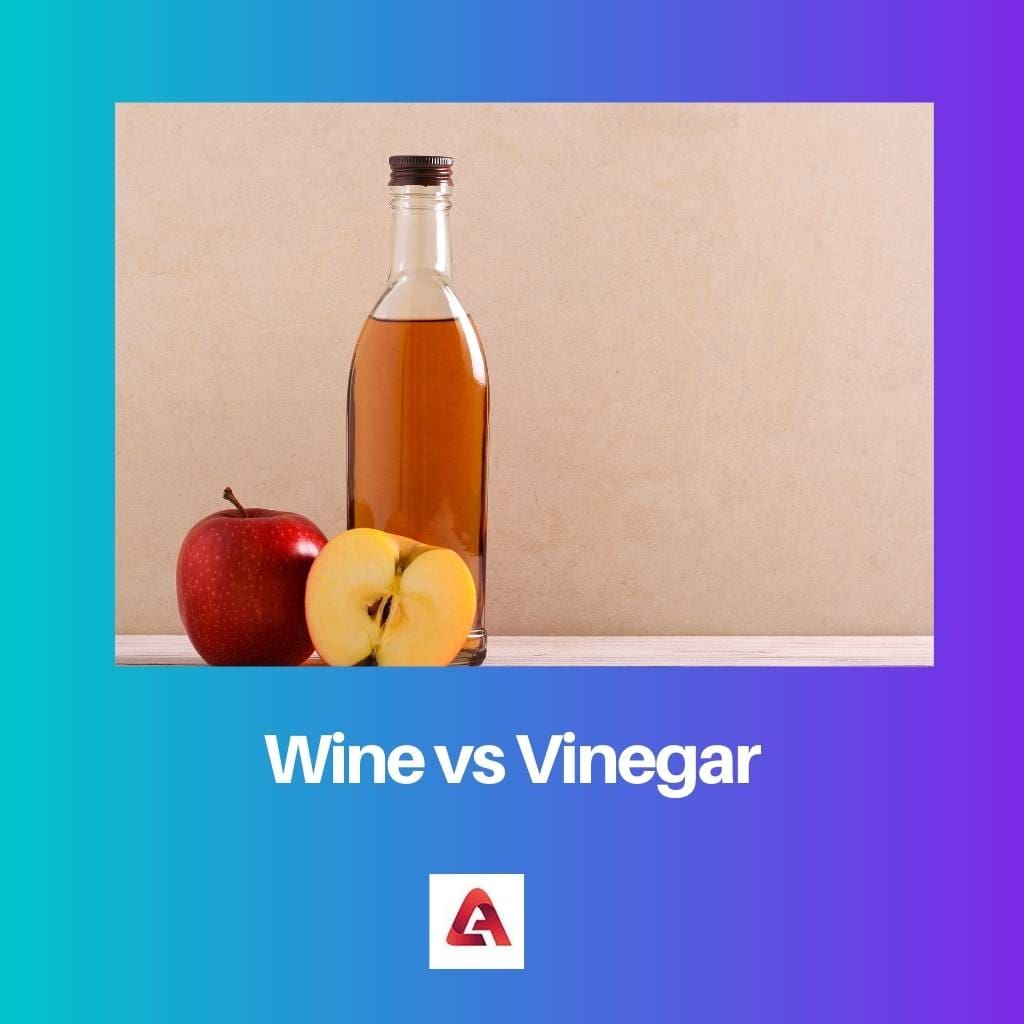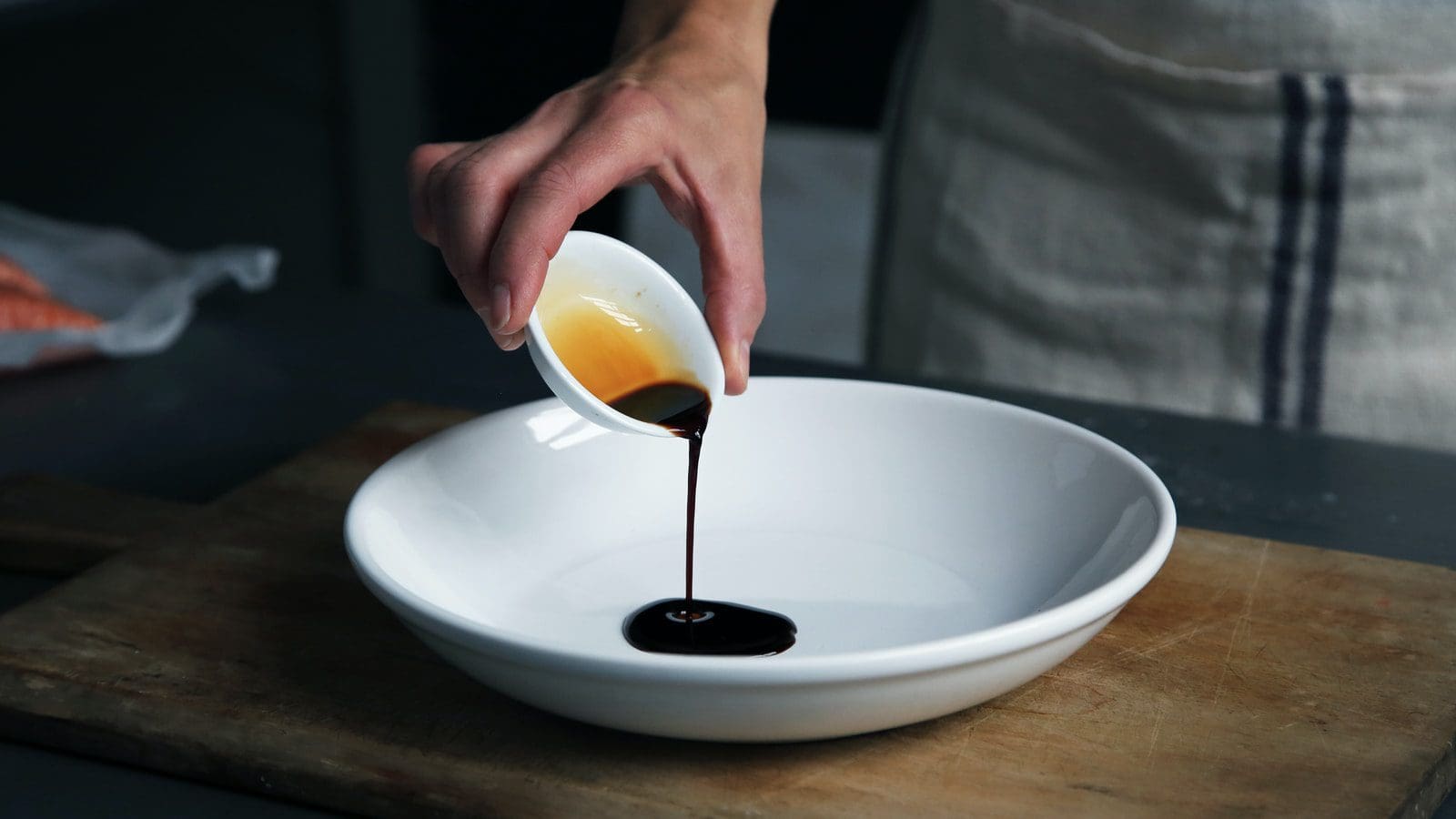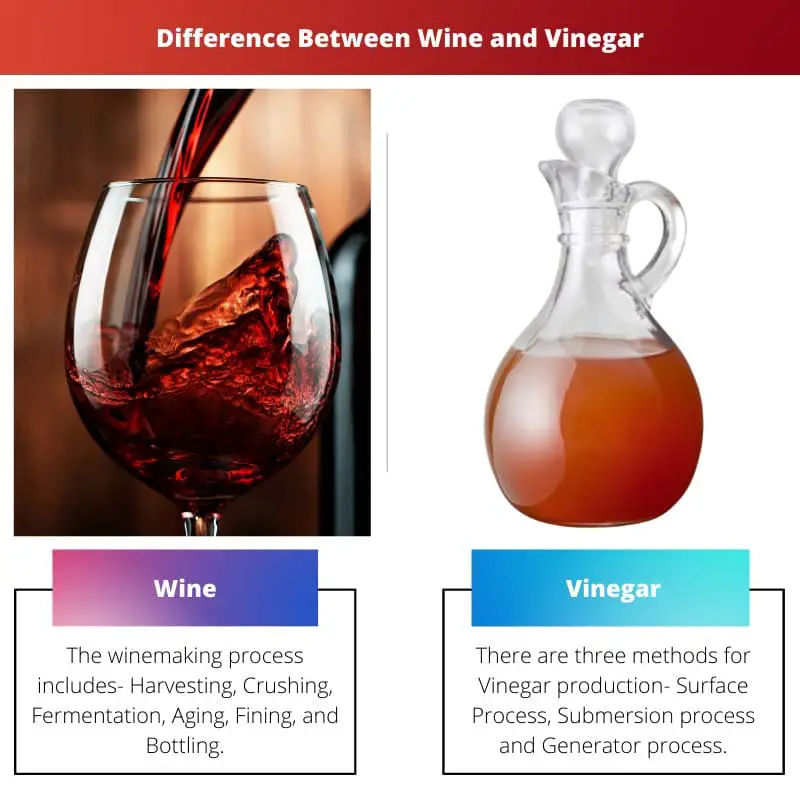A beverage or a drink is a specifically processed liquid human can consume and play an essential role in human culture. Various glasses are available, like water, milk, tea, coffee, alcohol, juices and soft drinks.
Along with these, there are alcoholic drinks like liquor, wine, and beer available too.
Key Takeaways
- Wine is an alcoholic beverage made from fermented grapes or other fruits, and white vinegar is a sour-tasting liquid made from the fermentation of alcohol, wine.
- Wine is consumed as a beverage, while vinegar is primarily used as a condiment or preservative.
- Wine has a higher alcohol content and a sweeter taste, while vinegar has a lower alcohol content and a sour taste.
Wine vs Vinegar
Wine is an alcoholic drink, and Vinegar is an item used to prepare other dishes. They both undergo the fermentation process for preparation. But there are still many differences between the two regarding introduction, taste, purpose and edibility.

Wine is an alcoholic beverage obtained by the fermentation of grape juice. Even though it is an alcoholic drink, it has a sufficiently low concentration of alcohol in it.
There are different types of Wine like Red, White, Grape, and others.
Vinegar is a solution that can be dissolved in water made of acetic acid and a few chemicals. It is obtained by fermentation and used for preparing for flavouring or making pickles.
Different types of vinegar are available such as fruit or palm vinegar.
Comparison Table
| Parameters of Comparison | Wine | Vinegar |
|---|---|---|
| Etymology | The wine originates in Old English, Latin, Arabic and German words. | It is derived from the Old French word vinegar, meaning ‘sour wine.’ |
| Origin | The earliest evidence goes back to 6000 BC and 4000 BC. | The earliest evidence goes back to a period around 3000 BC. |
| Production | The winemaking process includes- Harvesting, Crushing, Fermentation, Aging, Fining, and Bottling. | There are three methods for Vinegar production- Surface Process, Submersion process and Generator process. |
| Taste | It is a combination of sweet, sour, salty, and bitter. | It tastes most commonly sour. |
| Purpose | Wine is an alcoholic beverage. | Vinegar is a condiment used in various recipes. |
| Consumption | It can be consumed directly. | It cannot be consumed directly. |
What is Wine?
Wine is an alcoholic beverage that is meant for direct consumption by humans. The wine originates in West Asia, including the Caucasus Mountains, Zagros Mountains, Euphrates River Valley, and Southeastern Anatolia.
The area comprises the modern-day nations of Armenia, Azerbaijan, Georgia, northern Iran, and eastern Turkey.
Outside the Armenian village of Areni resided the oldest known winery in a group of caves. The winery came into existence in 4100 Bc, and the villagers continue to produce Wine and are still known for winemaking.
Wine is made from the fermentation process of the grapefruit.
However, from a winemaker’s point of view, the whole process of making Wine starts from the vineyard. To produce high-quality wine, you must grow high-quality grapes that require significant effort, care and attention.
The makers regularly test these fruits; finally, the best ones get picked for the other process during the harvest. These high-quality grapes are further taken into the wine cellars for preparation.
They are crushed and pressed for the fermentation process.
After the fermentation process is over, then comes the ageing process. There are different options available for ageing Wine. Post ageing, the Wine is filtered and later Bottled. The last but most crucial step is wine testing and tasting.

What is Vinegar?
In simple words, Vinegar is a mixture of acetic acid and water used to prepare various food items for flavouring, adding acidity, and pickling. Even though it is a cooking ingredient, it is not meant for direct consumption.
It is also used for cleaning purposes.
Vinegar production is as old as Alcohol production. However, the primary documented proof of Vinegar production and exploitation was of the traditional Babylonians around 3000 BC.
Vinegar was made up of dates, figs, and beer and used for cooking and healthful functions; it conjointly has traces in Egyptian urns.
Vinegar is created by an activity of Vinegar fermentation, during which alcohol is remodelled into Vinegar by vinegar bacteria.
There are different strategies for manufacturing Vinegar, together with the Surface, Submersion, and Generator methods.
The surface method is additionally known as the Orleans method, where a container with alcohol and vinegar bacteria is left to square open.
The Submersion method is also known as the acetate method, where bacteria are perpetually submerged within the liquid, and Pure oxygen is blown into the fermentation medium.
And within the generator method, the bacterium adheres to a carrier material (filling material), on which they are nearly “trapped”.

Main Differences Between Wine and Vinegar
- Wine derives from the Old English word ‘wine produced- wean’, the Latin word ‘vinum’ related to ‘vinya’, and the Arabic word- ‘wain’. Vinegar derives from the Old French word vyn egre, meaning ‘sour Wine.
- The earliest evidence of wine is found between 6000 BC and 4000 BC, and that of Vinegar around 3000 BC.
- The production of Wine comprises several standard stages, namely Harvesting, Crushing, Fermentation, Aging, Fining, and Bottling. At the same time, Vinegar production contains Vinegar fermentation by Surface Process, Submersion process or Generator process.
- Wine blends sweet, sour, salty, and bitter tastes. On the contrary, Vinegar tastes sour.
- Wine is an alcoholic drink, and Vinegar is a non-alcoholic drink used in dishes.
- Wine can be easily consumed by direct consumption. In contrast to Wine, it isn’t easy to consume Vinegar directly.




